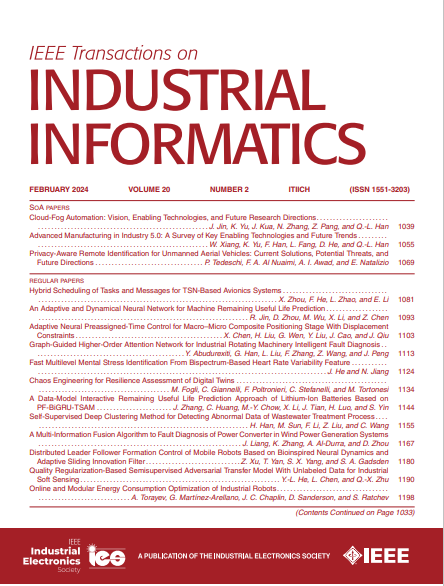弱电网下随网逆变器的数据驱动在线稳定性监测
IF 11.7
1区 计算机科学
Q1 AUTOMATION & CONTROL SYSTEMS
引用次数: 0
摘要
本文提出了一种利用实时输出电流的数据驱动在线稳定监测方法。对弱电网中随网逆变器的稳定性进行了判断。主流的方法依赖于阻抗测量,它需要在扰动注入的大小和持续时间以及测量精度之间进行权衡。相比之下,该方法首次使用人工智能技术基于实时电流数据对逆变器进行稳定性监测,无需注入干扰即可实现快速、准确的稳定性评估,从而保持逆变器的正常运行。将输出电流的单一变量巧妙地扩展为包含多个特征,并设计了一种新的多方面特征融合(MAFF)模型来提取这些扩展的特征。实验结果表明,该方法的样本加载间隔为10 ms,平均分类准确率为98%,平均报警延迟小于27 ms。此外,训练后的MAFF模型对宽带振荡监测具有较强的适应性,能有效适应不同参数的随网逆变器。本文章由计算机程序翻译,如有差异,请以英文原文为准。
Data-Driven Online Stability Monitoring of Grid-Following Inverters in Weak Grid
This article proposes a data-driven online stability monitoring method using real-time output currents. It contributes to stability judgement for grid-following inverters in weak grid. The mainstream approach relies on impedance measurement, which has a tradeoff between disturbance injection magnitude and duration and measurement accuracy. In contrast, the proposed approach, which is the first to use artificial intelligence technology for stability monitoring of inverters based on real-time current data, enables rapid, and accurate stability assessment without requiring disturbance injection, thus preserving normal inverter operation. The single variate of output currents is skillfully expanded to incorporate multiple features and a novel multiaspect feature fusion (MAFF) model is designed to extract these expanded features. Experimental results demonstrate that the proposed method achieves a sample loading interval of 10 ms, an average classification accuracy of 98%, and an average alarm delay of less than 27 ms. Furthermore, the trained MAFF model shows strong adaptability in wideband oscillation monitoring and can effectively accommodate grid-following inverters with different parameters.
求助全文
通过发布文献求助,成功后即可免费获取论文全文。
去求助
来源期刊

IEEE Transactions on Industrial Informatics
工程技术-工程:工业
CiteScore
24.10
自引率
8.90%
发文量
1202
审稿时长
5.1 months
期刊介绍:
The IEEE Transactions on Industrial Informatics is a multidisciplinary journal dedicated to publishing technical papers that connect theory with practical applications of informatics in industrial settings. It focuses on the utilization of information in intelligent, distributed, and agile industrial automation and control systems. The scope includes topics such as knowledge-based and AI-enhanced automation, intelligent computer control systems, flexible and collaborative manufacturing, industrial informatics in software-defined vehicles and robotics, computer vision, industrial cyber-physical and industrial IoT systems, real-time and networked embedded systems, security in industrial processes, industrial communications, systems interoperability, and human-machine interaction.
 求助内容:
求助内容: 应助结果提醒方式:
应助结果提醒方式:


